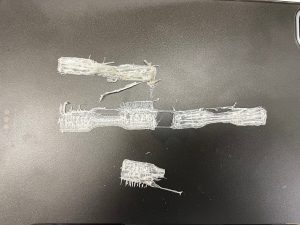1. Project Outline
The primary objective of this project is to explore the mechanical anisotropy in parts fabricated using Fused Filament Fabrication (FFF) Printing. This investigation focuses on understanding how the material type and the printing process parameters influence the mechanical properties of the printed parts. Our approach encompasses two main activities: printing sample parts with varied parameters and conducting tensile testing on these samples. Utilizing the FUSED FORM minilab printer at the Polymer Engineering Center, we have successfully completed the preparation of Polylactic Acid (PLA) samples. The next phase will involve tensile testing of these prepared samples.
2. Sample Printing
2.1. Material Characterization
For our project, PLA and Acrylonitrile Butadiene Styrene (ABS) filaments, sourced from the Polymer Engineering Center, were selected. We first analyzed their chemical composition. By dissolving the samples in CDCl3, we initially conducted Nuclear Magnetic Resonance (NMR) and Gel Permeation Chromatography (GPC) characterizations to determine the molecular structure and molecular mass distribution of the polymer materials.
2.1.1. NMR Characterization
Through the NMR hydrogen (H) spectra, we identified the molecular structure of the repeat units by determining the chemical shifts of hydrogen atoms in various chemical environments. The analysis allowed us to quantify the proportion of hydrogen atoms, inferring the molecular structure of the repeat units. Figure 1 illustrates the molecular structures of PLA (1a) and ABS (1b). Notably, the PLA spectrum showed unexpected chemical shifts at 1.8 ppm and 3.8 ppm, suggesting the possible presence of additives introduced during the manufacturing process to enhance filament production or mechanical properties.
 Figure 1 a) H1-NMR of PLA filament b) H1-NMR 0f ABS filament
Figure 1 a) H1-NMR of PLA filament b) H1-NMR 0f ABS filament
2.1.2. GPC Analysis
The GPC results revealed the molecular weights and polydispersity index (PDI) of our materials. For PLA, the number-average molecular weight (Mn) was found to be 95,283 g/mol, with a weight average molecular weight (Mw) of 170,582 g/mol and a PDI of 1.793. For ABS, the Mn was 67,772 g/mol, Mw was 116,342 g/mol, and the PDI was 1.717. These PDI findings indicate the presence of additives in our materials, as evidenced by the lower than expected molecular weights and PDI values. Following this analysis, sample parts were printed using these filaments for further testing.
As we progress towards the mechanical testing phase, these characterization results provide a valuable reference point for analyzing the impact of printing parameters on the anisotropy of FFF parts. Understanding the material composition allows us to make more informed hypotheses about the observed mechanical behaviors, facilitating a deeper exploration into the optimization of FFF technology for engineering applications.
2.2. Printing Testing Samples
In the pursuit of understanding the impact of printing parameters on the mechanical anisotropy of Fused Filament Fabrication (FFF) parts, our investigation has initially focused on Polylactic Acid (PLA) materials. Following our project plan, we meticulously adjusted various printing parameters during the fabrication process, including build orientation, layer height, and layer width. These adjustments are crucial for studying how each parameter influences the final mechanical properties of the printed samples. The specific settings employed in our experiments are detailed in Table 1.
Table 1 Printing Parameters Setting
| Sample | Material | Build Orientation | Layer Height (mm) | Layer width (mm) | Thickness T (mm) | Width W (mm) | Tensile Strength (MPa) | Tensile Modulus (GPa) | A_E | A_? |
|---|---|---|---|---|---|---|---|---|---|---|
| 1 | PLA | 0° | 0.1 | 0.5 | 2.1 | 3.5 | ||||
| 2 | PLA | 90° | 0.1 | 0.5 | 2.2 | 3.5 | ||||
| 3 | PLA | 0° | 0.2 | 0.5 | 2.3 | 3.4 | ||||
| 4 | PLA | 90° | 0.2 | 0.5 | 2.3 | 3.4 | ||||
| 5 | PLA | 0° | 0.1 | 0.8 | 2.2 | 3.4 | ||||
| 6 | PLA | 90° | 0.1 | 0.8 | 2.3 | 3.3 | ||||
| 7 | PLA | 0° | 0.2 | 0.8 | 2.2 | 3.3 | ||||
| 8 | PLA | 90° | 0.2 | 0.8 | 2.4 | 3.5 |
2.2.1. Printing Process and Problems Encountered
During the initial stages of our Fused Filament Fabrication (FFF) printing process, we encountered a significant issue that prevented us from producing samples with the intended dimensions and shapes, as illustrated in Figure 2. Despite thorough checks of our STL model files and printing parameters, the problem persisted, which led to a comprehensive analysis of our printing environment. This investigation revealed that the nozzle of the minilab printer was not properly tightened. Addressing this by tightening the nozzle resolved the issue, emphasizing the critical role of the nozzle’s condition in extrusion-based FFF printing. A loosely tightened nozzle can lead to filament leakage, inconsistent extrusion, misalignment, heat transfer issues, and increased wear and tear, all of which can drastically affect the quality of the print and the longevity of the printer.
Following this corrective action, we successfully printed samples with the parameters outlined in Table 1, as shown in Figure 3. We also conducted measurements of each sample’s dimensions, as shown in Table 1. While there were some deviations, the samples are deemed to meet the requirements for the forthcoming tensile testing phase.
3. Next Steps
We have reached out to Edward Chen for training in tensile testing to further advance our project. This step is critical for assessing the mechanical properties of our printed samples accurately. Upon successful completion of the tensile testing for PLA samples, we plan to extend our research to include samples printed with ABS material. This progression will allow us to comprehensively understand the impact of printing parameters and material properties on the anisotropy of FFF printed parts, laying the groundwork for optimizing printing strategies for enhanced material performance in practical engineering applications.
 Figure 2
Figure 2 Figure 3
Figure 3